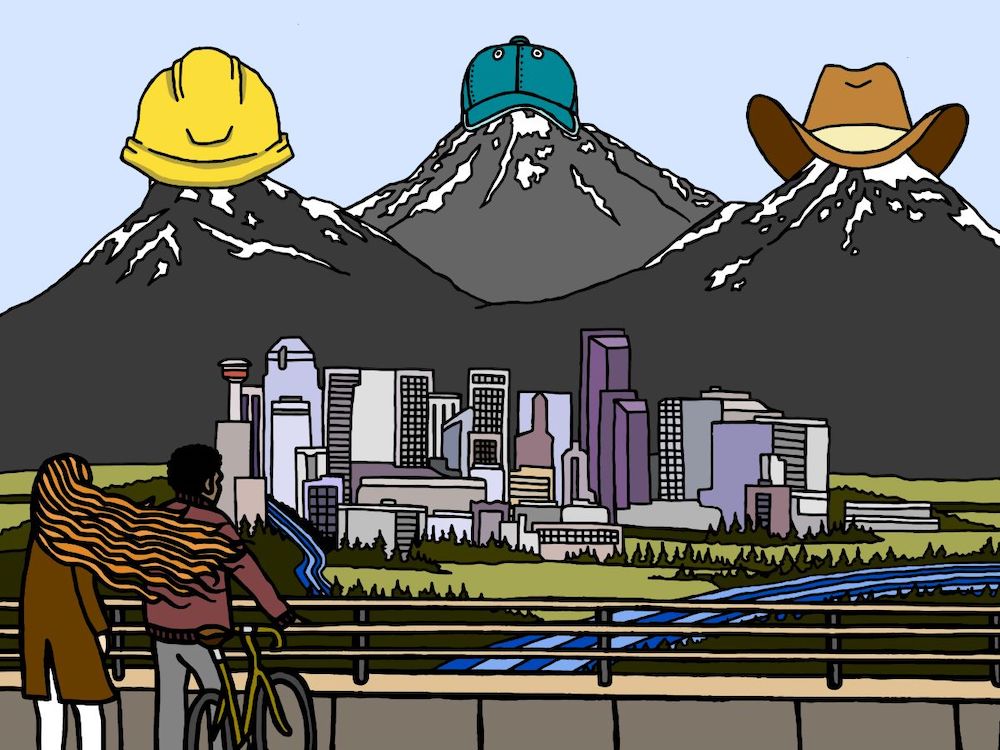What image comes to mind first when you picture an Albertan? If you’re like most of the folks we’ve met over the past four years, you imagined someone clad in plaid standing outdoors next to a pickup truck. Not everyone sees precisely the same thing, but the commonalities are rooted in stereotypes that define what it means to be Albertan.
Stereotypes are important threads in our social fabric. They influence our snap judgments and guide us through uncertain situations. These mental shortcuts simplify the complexities of our world, but they can also limit our sense of what’s possible.
We often think of stereotypes as caricatures of small groups of people, be they defined by ethnicity, gender, age or other factors. But what happens when stereotypes become the defining image of an entire community? This is a challenge that many Albertans face daily, often without even realizing it.
When our Common Ground team asked people to "draw me an Albertan," an overwhelming majority conjured up one of three personas: a cowboy, a farmer or a roughneck. Remarkably, this mental image held true across the board. Young people, progressives, newcomers and city dwellers were every bit as likely to draw a male, blue-collar worker as conservative folks who have lived in rural Alberta all of their lives.
The pervasiveness of this stereotype tells us that most Albertans share a common notion of what it means to be part of our provincial community. However, it also points to the limitations of our collective identity.
The natural role of stereotyping
Stereotypes serve a purpose. Our brains are wired to conserve cognitive resources, and evaluating every individual we encounter can be overwhelming. Stereotypes help us categorize people, making quick decisions about who to trust and who might pose a threat to our way of life. We develop stereotypes through the influence of family, friends, schools, media and governments, which reinforce our existing beliefs.
Despite their utility, stereotypes have inherent limitations, leading to overgeneralizations, bias and prejudice. This can give rise to divisions between "us" and "them," which underlie nationalistic, racist and other tribalistic tendencies.
When we apply these stereotypes to our own communities, it can lead to both unity and constraints on self-expression.
When stereotypes define ‘us’
Our research shows that the stereotypical Albertan is often seen as a middle-aged, white male from a rural area, and many refer to him as "Joe." These cultural caricatures play a role in forging collective identities, fostering pride, preserving traditions and setting a common understanding of community membership.
However, when a community's identity is rooted too deeply in these generic personas, it can create internal tensions. Stereotypes define what it means to be a member of the mainstream. People who resemble or feel comfortable alongside these personas are likely to feel like they belong. Those who don’t may feel excluded. People may feel pressured to conform to norms, leading to ritualistic behaviours. Just ask business people and politicians who make the costumed pilgrimage to the Calgary Stampede each July to pay homage to the province’s Wild West roots. Nonconformists may face ridicule or discrimination, pushing them to self-censor or even leave the community.
When personas come under threat
Generic personas like Joe are built to resist change. Challenging the established image is viewed as a deviation from tradition, hindering the community's ability to adapt to social, cultural and economic changes. Whether framed as resilience or preservation, this dynamic is familiar to communities such as the American Rust Belt, U.S. coal country and the industrial heartland in the U.K.
Be it a factory worker, coal miner or other labourer, each community’s cultural caricature involved some form of middle-aged, blue-collar, white man (not unlike Joe). Their role in “building” postwar prosperity was once revered, creating the foundation for a rich cultural heritage. It also helped deepen the region’s dependence on its dominant industry to the point that, when it failed, entire communities faded both economically and culturally.
This should be a familiar story to Atlantic Canadians who three decades ago were forced to transition their communities away from a dependence on the cod fishery.
Albertans now face similar challenges as their oil and gas industry undergoes upheaval. The romanticized image of the roughneck is under threat. At the same time automation reduces their numbers, many feel as if they are "falling behind" compared with white-collar professionals, those in the service industries and the new leaders of the “knowledge economy.”
The decline of these iconic personas has far-reaching effects, not just on those directly impacted but also on others in declining communities and nearby cities. When a community's persona is threatened, everyone feels it.
Rallying around and against the stereotype
This cultural clash leads to polarization. Some seek to shift the paradigm, painting the cultural caricature and all it represents as backward. To move forward, they seek to erase the persona from public view, replacing it with a more progressive, reflective and diverse representation of what it means to be part of the community. While paying lip service to the need to take care of the people most affected by the transition, their focus is on moving ahead. A small number see the oil and gas workers as personally responsible for their own plight, with most blaming the fossil fuel companies and their friends in government for duping them into believing that the boom times will last forever.
Their opponents double down and defend the caricature. They blame outside forces, malign reformers as being disloyal and treat any effort to transition the economy and society away from its historic image as traitorous. In an effort to restore their status, they turn inward, building stronger bonds within their declining communities. They look to strengthen ties to their “heritage” by revising school curriculums, building and defending monuments to their heroes and establishing state symbols that pay tribute to their vision of the past. They pass laws and pursue policies that forbid others to challenge the positive legacy of their forebears. They mock and attack people who appear to threaten the way things used to be, branding them members of “the establishment” and “elite.” These moves are all part of an official drive to make our communities “great again.”
The majority of Albertans, however, find themselves in between these extremes. They recognize the need for economic transition but also value the contributions of the industry's workers. They don't want to "cancel" Joe but wish to be acknowledged, themselves, for moving the province forward culturally and economically.
Moving forward with Joe and others
How do we overcome the natural tendency to stereotype ourselves, or at least mitigate against its ill effects? The first step is to recognize our own biases and those of others as being natural. We all succumb to stereotyping, but if we surface these assumptions we can begin to address them. This includes being critical of public portrayals and representations of the "typical" members of different communities. It also means catching ourselves when our minds drift into thinking about how the "typical" Albertan would react negatively to change.
Second, it is important to step outside our comfort zone and get to know people who appear to conform to our stereotypical views in order to empathize with them. At the same time, engaging people from various backgrounds and cultures who don’t conform to the dominant stereotypes can broaden our perspective. Sharing stories, statistics and examples that counter the monolithic tendency of stereotyping is crucial to challenging our preconceptions. We need to dedicate time and resources to making these connections, building two-way bridges between rural and urban communities across our province. Establishing youth exchanges could be a small first step in this process.
Ultimately, breaking free from stereotypes is about fostering understanding and appreciating the diversity within our communities. Fortunately, most Albertans are already there on a personal level. The stereotypes, themselves, are holding us back from expanding that common ground. ![]()
Read more: Rights + Justice, Alberta


















Tyee Commenting Guidelines
Comments that violate guidelines risk being deleted, and violations may result in a temporary or permanent user ban. Maintain the spirit of good conversation to stay in the discussion and be patient with moderators. Comments are reviewed regularly but not in real time.
Do:
Do not: